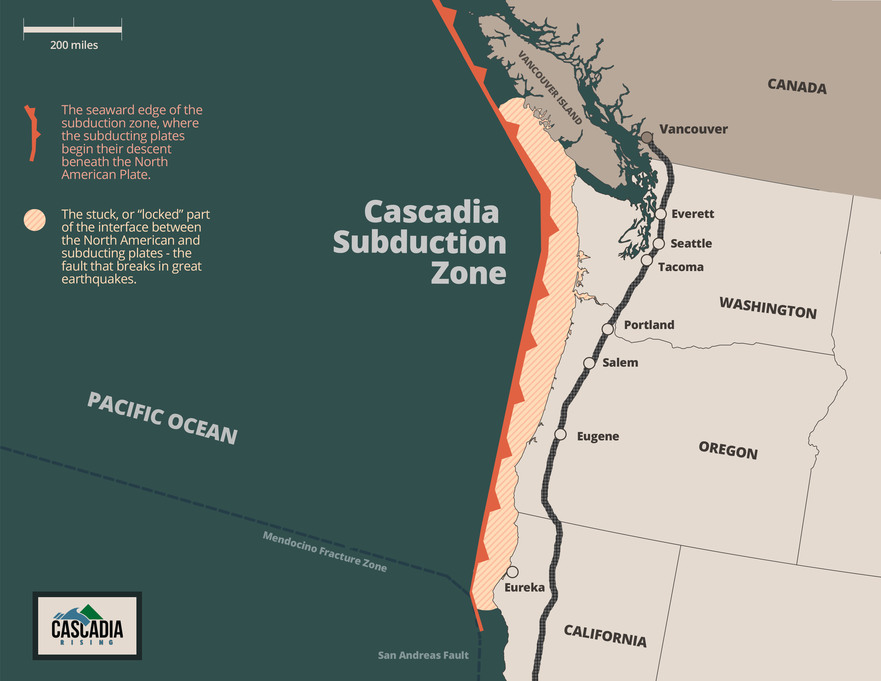A year following one of the nation’s largest domestic drills, lessons-learned continue to guide strategies that improve the Pacific Northwest’s ability to survive and recover from a catastrophic Cascadia Subduction Zone (CSZ) earthquake and tsunami.
On June 7, 2016, more than 20,000 emergency managers in Idaho, Oregon and Washington kicked off Cascadia Rising 2016, a four-day, large scale exercise to test response and recovery capabilities in the wake of a 9.0 magnitude CSZ earthquake and tsunami. The exercise involved local, state, tribal and federal partners, along with military commands, private sector and non-governmental organizations.
Lessons learned from Cascadia Rising 2016
“I’m pleased the momentum from Cascadia Rising continues to gain speed,” said Maj. Gen. Bret Daugherty, director of the Washington Military Department and commander of the Washington National Guard. “As a result of the exercise, our governor directed the formation of a Resilient Washington sub-cabinet, a multi-agency workgroup charged with improving our state’s resiliency. Cascadia Rising also guided our decision to change our recommendation on preparedness, so we’re now telling people to have enough emergency supplies to stay on their own for up to two weeks.”
“Cascadia Rising was the largest exercise the State of Oregon has ever conducted. The complexity of the four-day exercise provided an unprecedented opportunity to examine and assess response and emergency management practices, and identify areas where we excel and where we can improve,” said Oregon Office of Emergency Management Director Andrew Phelps. “The collaboration among all levels of government, and with our private sector partners leading up to and during the exercise, was outstanding. I believe these relationships were strengthened through this experience and will continue to grow as we work toward enhancing our preparedness posture.”
“In addition, Cascadia Rising served as a reminder to all Oregonians that individual and family emergency preparedness is key to an effective response to an earthquake or any disaster and begin the recovery process,” said Phelps. “As we constantly improve our capabilities, we ask all to be prepared for at least two weeks.”
Idaho’s participation helped raise awareness that the residual effects of an earthquake and tsunami along the coast would be felt in Idaho. That includes the possible need to accommodate tens of thousands of evacuees and displaced persons who were directly impacted.
“The countless strong partnerships we cultivated in the years leading up to the exercise proved invaluable to the success of Cascadia Rising in Idaho,” said Gen Brad Richy, of the Idaho Office of Emergency Management. “The collaboration with FEMA Region 10, and our Idaho counties, is proving indispensable as Idaho currently manages one of the most challenging flood seasons on record. Thirty-one of Idaho’s 44 counties have disaster declarations in place right now. When people ask about the importance of exercises, I like to point out that lessons learned during Cascadia Rising 2016 have improved our swift and effective response to the 2017 flooding disasters.”
“The Cascadia Rising 2016 exercise highlighted a number of critical areas that we, the emergency management community, should improve before this fault ruptures, which will impact large portions of our residents and infrastructure. It is exercises like this, that foster coordination and help build relationships before a real-world event occurs,” said Sharon Loper, Acting FEMA Region 10 Administrator. “The exercise highlighted a number of infrastructure interdependencies our residents have come to rely on, such as electricity, communications, fuel, water and our roads. Most of these sectors would be heavily disrupted after a CSZ event and plans are being developed and exercised that focus on the efficient recovery of these essential services. In this past year, FEMA Region 10 has made improvements in coordinating disaster logistics, family reunification strategies and mass power outage scenarios with our partners.”
“Every exercise teaches us something and improves our response,” said Loper. “I’m pleased so many partners and community members collaborate on these important issues. We should continue to work together so that we are all better prepared to protect lives and property.”
Background
Lying mostly offshore, the plate interface that is the Cascadia Subduction Zone is a giant fault approximately 700 miles long. At this location, the set of tectonic plates to the west is sliding (subducting) beneath the North American plate. Friction prevents movement of these two plates; ultimately, these plates are stuck. The stress of these boundaries is continuously building until the fault suddenly breaks, resulting in a potentially devastating 700-mile earthquake and ensuing tsunami along the California, Oregon and Washington coastlines. Last year’s Cascadia Rising 2016 exercise was to test plans and procedures through a 9.0M earthquake and follow-on tsunami with expectations to improve catastrophic disaster operational readiness across the whole community.
A 9.0 magnitude earthquake along the Cascadia Subduction Zone (CSZ) and the resulting tsunami is the most complex disaster scenario that emergency management and public safety officials in the Pacific Northwest could face. Cascadia Rising was an exercise to address that disaster.
June 7-10, 2016 Emergency Operations and Coordination Centers (EOC/ECCs) at all levels of government and the private sector activated to conduct a simulated field response operation within their jurisdictions and with neighboring communities, state EOCs, FEMA, and major military commands.
Conducting successful life-saving and life-sustaining response operations in the aftermath of a Cascadia Subduction Zone disaster hinged on the effective coordination and integration of governments at all levels – cities, counties, state agencies, federal officials, the military, tribal nations – as well as non-government organizations and the private sector. One of the primary goals of Cascadia Rising was to train and test this whole community approach to complex disaster operations together as a joint team.
Recent subduction zone earthquakes around the world underscore the catastrophic impacts we will face when the next CSZ earthquake and tsunami occurs in our region:
Indonesia (2004): M9.1 — 228,000 fatalities
Chile (2010): M8.8 — 500 fatalities
Japan (2011): M9.0 — 18,000 fatalities
– Department of Homeland Security









